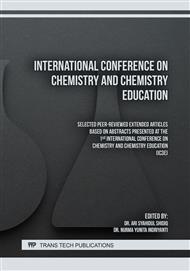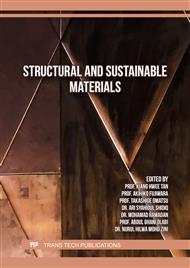[1]
Peraturan Pemerintah Republik Indonesia Nomor 82 Tahun 2001 Tentang Pengelolaan Kualitas Air dan Pengendalian Pencemaran Air Pasal 1 Ayat (11) Tentang Pencemaran Air
DOI: 10.30957/supremasi.v7i1.373
Google Scholar
[2]
Bahadur, N., & Bhargava, N. (2019). Novel pilot scale photocatalytic treatment of textile & dyeing industry wastewater to achieve process water quality and enable zero liquid discharge. Journal of Water Process Engineering, 32; 100934. https://doi.org/10.1016/j.jwpe. 2019.100934
DOI: 10.1016/j.jwpe.2019.100934
Google Scholar
[3]
Ding, L., Zou, B., Gao, W., Liu, Q., Wang, Z., Guo, Y., Wang, X., & Liu, Y. (2014). Adsorption of Rhodamine-B from aqueous solution using treated rice husk-based activated carbon. Colloids and Surfaces A: Physicochemical and Engineering Aspects. 446; 1–7.
DOI: 10.1016/j.colsurfa.2014.01.030
Google Scholar
[4]
Guzel, F., Sayğılı H., Sayğılı, A., & Koyuncu, F. (2014). Decolorization of aqueous crystal violet solution by a new nanoporous carbon : Equilibrium and kinetic approach. Journal of Industrial and Engineering Chemistry. 20(5); 3375–3386.
DOI: 10.1016/j.jiec.2013.12.023
Google Scholar
[5]
Goswami, M. & Phukan, P. (2017). Journal of Environmental Chemical Engineering Enhanced adsorption of cationic dyes using sulfonic acid modified activated carbon. Journal of Environmental Chemical Engineering. 5(4). 3508–3517.
DOI: 10.1016/j.jece.2017.07.016
Google Scholar
[6]
Üner, O., Gecgel, ü., Kolancilar, H. & Bayrak, Y. (2017). Adsorptive Removal of Rhodamine B with Activated Carbon Obtained from Okra Wastes. Chemical Engineering Communications. 204 (7); 772–783.
DOI: 10.1080/00986445.2017.1319361
Google Scholar
[7]
Liu, T. Li, Y., Du, Q., Sun, J., Jiao, Y., Yang, G., Wang, Z., Xia, Y., Zhang, W., Wang, K., Zhu, H., & Wu, D. (2012). Adsorption of methylene blue from aqueous solution by graphene. Colloids and Surfaces B: Biointerfaces. 90(1); 197–203.
DOI: 10.1016/j.colsurfb.2011.10.019
Google Scholar
[8]
Ghaedi, M., Nasab, A. G., Khodadoust, S., & Rajabi, M. (2014). Journal of Industrial and Engineering Chemistry Application of activated carbon as adsorbents for efficient removal of methylene blue : Kinetics and equilibrium study. Journal of Industrial and Engineering Chemistry. 20(4); 2317–2324.
DOI: 10.1016/j.jiec.2013.10.007
Google Scholar
[9]
Theydan, S. K. & Ahmed, M. J. 2012. Journal of Analytical and Applied Pyrolysis Adsorption of methylene blue onto biomass-based activated carbon by FeCl3 activation : Equilibrium, kinetics, and thermodynamic studies. Journal of Analytical and Applied Pyrolysis. 97; 116–122.
DOI: 10.1016/j.jaap.2012.05.008
Google Scholar
[10]
Keputusan Menteri Negara Lingkungan Hidup Nomor : KEP-51/MENLH/10/1995 Tentang Baku Mutu Limbah Cair Bagi Kesehatan Industri Pasal 2 Ayat (9).
DOI: 10.52364/jz.v1i1.1
Google Scholar
[11]
Melliti, A., Srivastava, V., Kheriji, J., Sillanpaa, M., & Hamrouni, B. (2021). Date Palm Fiber as a novel precursor for porous activated carbon: Optimization, characterization and its application as Tylosin antibiotic scavenger from aqueous solution. Surfaces and Interfaces, 24 (101047)
DOI: 10.1016/j.surfin.2021.101047
Google Scholar
[12]
Mazoochi, T., Hamadanian, M., Ahmadi, M., & Jabbari, V. (2012). Investigation on the morphological characteristics of the nanofibrous membrane as electrospun in the different processing parameters. International Journal of Industrial Chemistry. 3(1); 1–8.
DOI: 10.1186/2228-5547-3-2
Google Scholar
[13]
Ishak, M. R., Sapuan, S.m., Leman, Z., Rahman, M.Z.A., Anwar, U.M.K, & Siregar, J.P. (2013). Sugar palm (Arenga pinnata): Its fibers, polymers, and composites. Carbohydrate Polymers. 91(2); 699–710.
DOI: 10.1016/j.carbpol.2012.07.073
Google Scholar
[14]
Barroso-Bogeat, A., Alexandre-Franco., M., Ferna´ndez-Gonza´lez, C., Macı´as-Garcıa, A., & Go´mez-Serrano, V. (2014). Electrical Conductivity of activated carbon-metal oxide nanocomposites under compression a comparison study. Physical Chemistry Chemical Physics, 16 (45)
DOI: 10.1039/C4CP03952A
Google Scholar
[15]
Saha, B., Das, S., Saikia, J., & Das, G. (2011). Preferential and Enhanced Adsorption of Different Dyes on Iron Oxide Nanoparticles: A Comparative Study. The Journal of Physical Chemistry, 115: 8024-8033.
DOI: 10.1021/jp109258f
Google Scholar
[16]
Kalantry, R. R., Jafari, A. J., Esrafili, A., Kakavandi, B., Gholizadeh, A., & Azari, A. (2015). Optimization and Evaluation of Reactive Dye Adsorption on Magnetic Composite of Activated Carbon and Iron Oxide. Desalination and Water Treatment, 1-12
DOI: 10.1080/19443994.2015.1011705
Google Scholar
[17]
Amer, M., & Elwardany, A. (2020). Biomass Carbonization. Renewable Energy - Resources, Challenges and Applications, IntechOpen.
DOI: 10.5772/intechopen.90480
Google Scholar
[18]
Reza, R. A., & Ahmaruzzaman, M. (2015). A novel synthesis of Fe2O3@activated carbon composite and its exploitation for the elimination of carcinogenic textile dye from an aqueous phase. RSC Advances, 5(14); 10575–10586
DOI: 10.1039/c4ra13601b
Google Scholar
[19]
Al-Kady, A. S., Gaber, M., Hussein, M. M., & Ebeid, E.-Z. M. (2011). Structural and fluorescence quenching characterization of hematite nanoparticles. Spectrochimica Acta Part A: Molecular and Biomolecular Spectroscopy, 83(1); 398–405
DOI: 10.1016/j.saa.2011.08.052
Google Scholar
[20]
Xiao, W., Garba, Z. N., Sun, S., Lawan, I., Wang, L., Lin, M., & Yuan, Z. (2020). Preparation and evaluation of an effective activated carbon from white sugar for the adsorption of rhodamine B dye. Journal of Cleaner Production. 253; 119989.
DOI: 10.1016/j.jclepro.2020.119989
Google Scholar
[21]
Ilyas, R. A., Sapuan, S.M., Ibrahim, R., Abral, H., Ishak, M. R., Zainudin, E. S., Asrofi, M., Atikah, M. S. N., Huzaifah, M. R. M., Radzi, A. M., Azammi, A. M. N., Shaharuzaman, M. A., Nurrazi, N. M., Syafri, E., Sari, N. H., Norrahim, M. N. F., & Jumaidin, R. (2019). Sugar palm ( Arenga pinnata ( Wurmb .) Merr ) cellulosic fiber hierarchy : a comprehensive approach from macro to the nanoscale. Journal of Materials Research and Technology, 8(3), 2753–2766.
DOI: 10.1016/j.jmrt.2019.04.011
Google Scholar
[22]
Xiang, Z., Song, Y., Xiong, J., Pan, Z., Wang, X., Liu, L., Liu, R., Yang, H., & Lu, W. (2019). Enhanced electromagnetic wave absorption of nanoporous Fe3O4 @carbon composites derived from metal-organic frameworks. Carbon, 142, p.20–31.
DOI: 10.1016/j.carbon.2018.10.014
Google Scholar
[23]
Jia, Z., Li, Z., Li, S., Li, Y., & Zhu, R. (2016). Adsorption performance and mechanism of methylene blue on chemically activated carbon spheres derived from hydrothermally-prepared poly(vinyl alcohol) microspheres. Journal of Molecular Liquids, 220; 56–62.
DOI: 10.1016/j.molliq.2016.04.063
Google Scholar
[24]
Achaby, M. El., Fayoud, N., Figueroa-Espinoza, M. C., Ben youcef, H., & Aboulkas, A. (2018). New Highly Hydrated Cellulose Microfibrils with a Tendril Helical Morphology Extracted from Agro-waste Material: Application to Removal of Dyes from Waste Water. RSC Advances. 8; 5212–5224.
DOI: 10.1039/C7RA10239A
Google Scholar
[25]
Jin, Q., Zhu, X., Xing, X., & Ren, T. (2012). Adsorptive Removal of Cationic Dyes from Aqueous Solutions Using Graphite Oxide. Adsorption Science & Technology. 30(5); 437–447.
DOI: 10.1260/0263-6174.30.5.437
Google Scholar
[26]
Zhang, J., Li, F. & Sun, Q. (2018). Rapid and Selective Adsorption of Cationic Dyes by a Unique Metal-organic Framework with Decorated Pore Surface. Applied Surface Science. 440; 1219-1226
DOI: 10.1016/j.apsusc.2018.01.258
Google Scholar
[27]
Li, T. et al. (2018). Microporous and Mesoporous Materials Regulation of the surface area and surface charge property of MOFs by multivariate strategy : Synthesis, characterization, selective dye adsorption, and separation. Microporous and Mesoporous Materials. 272; 101–108
DOI: 10.1016/j.micromeso.2018.06.023
Google Scholar
[28]
Oladoye, P. O., Ajiboye, T. O., Omotola, E. O. et al. (2022). Methylene blue dye: Toxicity and potential elimination technology from wastewater. Results in Engineering, 16; 100678
DOI: 10.1016/j.rineng.2022.100678
Google Scholar
[29]
Radovic, L. R., Silva, I. F., Ume, J. I. et al. (1997). An experimental and theoretical study of the adsorption of aromatics possessing electron-withdrawing and electrondonating functional groups by chemically modified activated carbons. Carbon, 35(9); 1339–1348
DOI: 10.1016/S0008-6223(97)00072-9
Google Scholar
[30]
Savova, D., Petrov, N., Yardim, M. F. et al. (2003). The influence of the texture and surface properties of carbon adsorbents obtained from biomass products on the adsorption of manganese ions from aqueous solution. Carbon, 41(10); 1897–1903
DOI: 10.1016/S0008-6223(03)00179-9
Google Scholar
[31]
Karagoz, S., Tay, T., Ucar, S., & Erdem, M. (2008). Activated carbons from waste biomass by sulfuric acid activation and their use on methylene blue adsorption. Bioresource Technology, 99(14); 6214–6222
DOI: 10.1016/j.biortech.2007.12.019
Google Scholar
[32]
Raji, Y., Nadi, A., Mechnou, I. et al. (2023). High adsorption capacities of crystal violet dye by low-cost activated carbon prepared from Moroccan Moringa oleifera wastes: Characterization, adsorption and mechanism study. Diamond & Related Materials, 135; 109834
DOI: 10.1016/j.diamond.2023.109834
Google Scholar
[33]
Chen, B., Long, F., Chen, S. et al. (2020). Magnetic chitosan biopolymer as a versatile adsorbent for simultaneous and synergistic removal of different sorts of dyestuffs from simulated wastewater. Chemical Engineering Journal, 385; 123926
DOI: 10.1016/j.cej.2019.123926
Google Scholar
[34]
Yu, Y., Qiao, N., Wang, D. J. et al. (2019). Fluffy honeycomb-like activated carbon from popcorn with high surface area and well-developed porosity for ultra-high efficiency adsorption of organic dyes. Bioresource Technology, 285; 121340
DOI: 10.1016/j.biortech.2019.121340
Google Scholar
[35]
Wang, Q., Luo, C., Lai, Z. et al. (2022). Honeycomb-like cork activated carbon with ultra-high adsorption capacity for anionic, cationic and mixed dye: Preparation, performance and mechanism. Bioresource Technology, 357; 127363
DOI: 10.1016/j.biortech.2022.127363
Google Scholar



